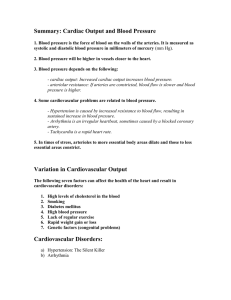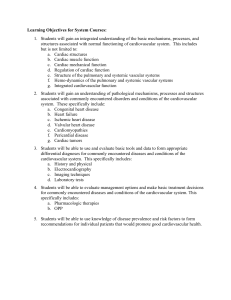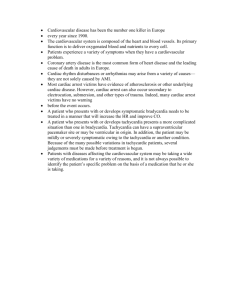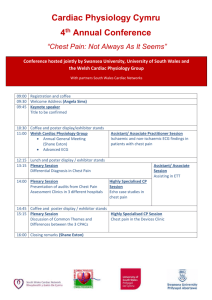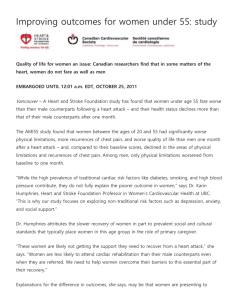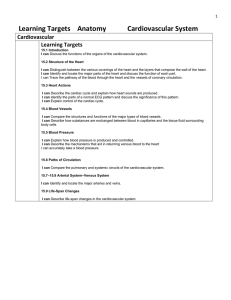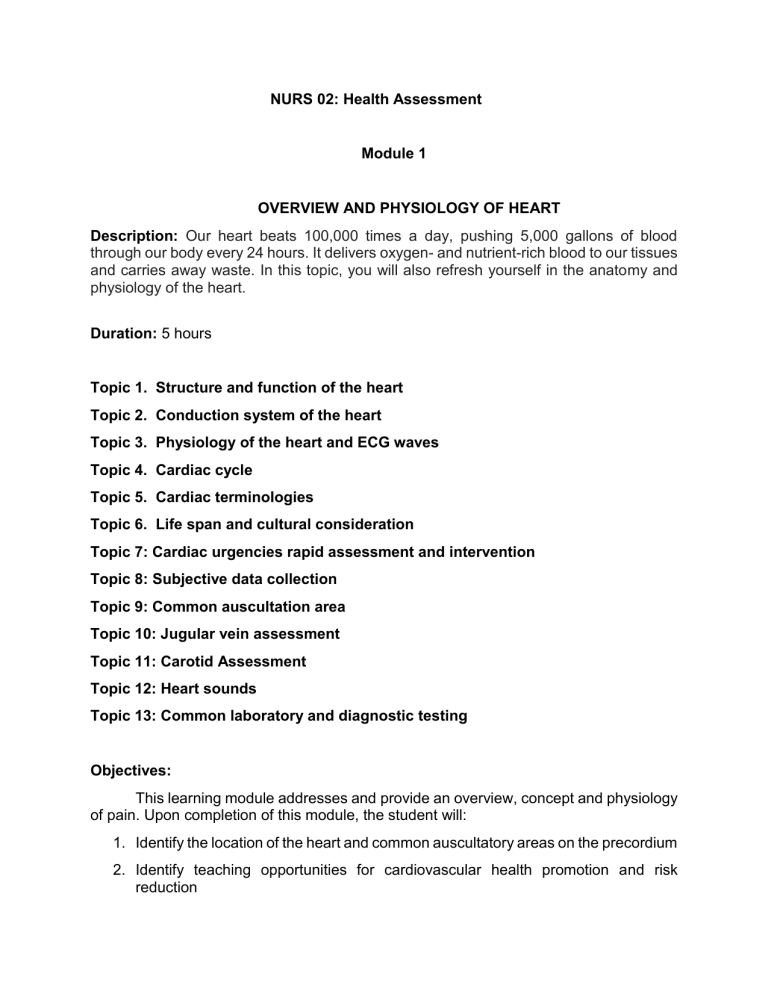
NURS 02: Health Assessment Module 1 OVERVIEW AND PHYSIOLOGY OF HEART Description: Our heart beats 100,000 times a day, pushing 5,000 gallons of blood through our body every 24 hours. It delivers oxygen- and nutrient-rich blood to our tissues and carries away waste. In this topic, you will also refresh yourself in the anatomy and physiology of the heart. Duration: 5 hours Topic 1. Structure and function of the heart Topic 2. Conduction system of the heart Topic 3. Physiology of the heart and ECG waves Topic 4. Cardiac cycle Topic 5. Cardiac terminologies Topic 6. Life span and cultural consideration Topic 7: Cardiac urgencies rapid assessment and intervention Topic 8: Subjective data collection Topic 9: Common auscultation area Topic 10: Jugular vein assessment Topic 11: Carotid Assessment Topic 12: Heart sounds Topic 13: Common laboratory and diagnostic testing Objectives: This learning module addresses and provide an overview, concept and physiology of pain. Upon completion of this module, the student will: 1. Identify the location of the heart and common auscultatory areas on the precordium 2. Identify teaching opportunities for cardiovascular health promotion and risk reduction 3. Collect subjective data r/t common cardiovascular symptoms including chest pain, dyspnea, diaphoresis, fatigue, edema, nocturia, and palpitations 4. Collect objective data r/t cardiac system utilizing accurate physical assessment techniques 5. Auscultate, interpret and differentiate normal and abnormal heart sounds 6. Identify expected and unexpected findings r/t the cardiovascular system 7. Analyze data and plan interventions r/t the cardiovascular system 8. Document data using appropriate medical terminology and communicate data regarding the cardiovascular system using clinical reasoning 9. Individualize cardiovascular health assessment considering the condition, age, gender and culture of the patient 10. Identify nursing diagnoses and initiate a plan of care based on findings from the cardiac assessment Learning Outcomes: On successful completion of this module, students should be able Identify the location of the heart and common auscultatory areas on precordium. to: 1. Identify teaching opportunities for cardiovascular health promotion and risk reduction. 2. Collect subjective data related to common cardiovascular symptoms including chest pain, dyspnea, diaphoresis, fatigue, edema, nocturia and palpitations. 3. Collect objective data related to the cardiac system utilizing accurate physical assessment techniques. 4. Auscultate, interpret and differentiate normal and abnormal heart sound. 5. Identify Expected and unexpected findings related to cardiac system including murmurs, rub and gallops. 6. Document data using appropriate medical terminology and gathered data using clinical reasoning. communicate 7. Individualized cardiovascular health assessment considering the condition, age, gender and culture of the patient. Methods/Instructional Technique Demonstration Questioning Video recording and simulation Listening Research work and analysis Self-Evaluation Supply Type of Test Materials Paper and Pen, Power point Presentation Use of instrument and basic equipment (dummy, video clips, pictures) Content Outline (Please refer on the provided power point presentation for the teaching aid Structure and function of the heart Auscultaion landmark Apex Base Arterial great vessels Venous great vessels Heart chamber Atrioventricular valve Semilunar valve Heart walls Pericardium Conduction system of the heart SA node AV node AV junction AV bundle of his Purkinje fibers Physiology of the heart and ECG waves S1 sound, s2 sound, P,Q,R,S, T waves Cardiac cycle Cardiac terminologies Stroke Volume Cardiac output Pre load After load Ejection Fraction Life span and cultural consideration Older adults Cardiac urgencies rapid assessment and intervention Symptoms Focused assessment Additional data assessment Data clustering Tips to reduce risk for heart disease Topic 8: Subjective data collection Common vascular symptoms Age related changes Equipment Preparation Common auscultation area Aortic area Pulmonic Area Erbs point Tricuspid Area Mitral Area Jugular vein assessment Technique Normal Findings Abnormal Findings Carotid Assessment Technique Normal Findings Abnormal Findings Precordium Heart sounds S1 S2 S3 S4 Common laboratory and diagnostic testing Learning Activities • A Black 50-year-old female client is admitted to the health care facility with mitral valve prolapse. The client states that a week ago she became dizzy and began to perspire while at work. She was working at the computer in her office on a major project that was due that day. The client attributed the episode to the stress and anxiety she was experiencing from finishing the project, so she put a cold wet towel around her neck and continued working. The next day, she woke up with a headache and felt a little tightness in her chest. She took an aspirin, and the symptoms subsided. The client became alarmed today when the tightness in her chest felt more like a pain. The client’s presenting symptoms include fatigue, headaches, and sharp chest pains. • A Black 50-year-old female client is admitted to the health care facility with mitral valve prolapse. The client states that a week ago she became dizzy and began to perspire while at work. She was working at the computer in her office on a major project that was due that day. The client attributed the episode to the stress and anxiety she was experiencing from finishing the project, so she put a cold wet towel around her neck and continued working. The next day, she woke up with a headache and felt a little tightness in her chest. She took an aspirin, and the symptoms subsided. The client became alarmed today when the tightness in her chest felt more like a pain. The client’s presenting symptoms include fatigue, headaches, and sharp chest pains. • VS: BP 160/90 mm Hg, HR 110 beats/min, RR 24 breaths/min, Temp. 98.0° F (36.7°C), Pulse Ox 96%, skin is warm; the nurse notes the client is perspiring. Her weight is 30 lb over what it should be. She gives a history of having a murmur since she was little but that it never caused her any problems. She takes cholesterol and blood pressure–lowering medications daily. 1. What are conditions that contribute to turbulent blood flow or heart murmurs? 2. What are three techniques used to assess the precordium and heart sounds? 3. Based on these symptoms and history, what is the correct landmark for auscultation of heart sounds in this client? 4. What kind of heart sounds may be heard in this client? 5. When teaching this client about coronary heart disease (CHD), which risk factors are important for the nurse to emphasize? 6. If the client asks the nurse if the murmur she has is causing the symptoms, how should the nurse respond?
